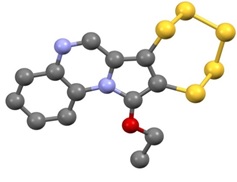Research
External Links to Our Research Activities
ERC-Project MocoModels at the Cordis website
Bioinorganic model chemistry and bioinspired reactivity
We investigate the bioinorganic chemistry of molybdenum and tungsten by means of combined structural and functional model chemistry, among other things with the aim of deciphering the mechanisms of metalloenzymes.
A second priority is to use molybdenum and tungsten for bioinspired reactivity with a focus on small molecule activation and second sphere effects.
Pentathiepines

As part of our work on the synthesis of models for the molybdenum cofactor, we accidentally discovered the molybdenum-mediated synthesis of N-heterocyclic pentathiepines. Pentathiepines are also found in nature, where they particularly exhibit fungicidal and antibacterial activity. Simple synthetic pentathiepines have been shown to interact with DNA. Our pentathiepines, which contain nitrogen heterocycles, are of unprecedented complexity and we are testing them in various approaches with regard to their interactions with biological systems. Detailed studies on structure-activity relationships are also currently being carried out. Pentathiepines therefore fall into the area of pharmaceutically relevant molecules. Depending on their structure, they exhibit cytotoxic, antibiotic or fungicidal activities and we can realize a large variety of structural motifs with a molybdenum-mediated synthesis.
Phosphate cages
Macrocyclic cage compounds are being optimized to bind or include phosphate ions and thus remove them from their current environment.
Waste wood analysis
We are working on waste wood analysis, which is an essential prerequisite for waste wood recycling and requires modernization and optimization. Here we are developing an X-ray fluorescence-based methodology to bypass wet chemical pulping and to be able to analyze wood as a solid.
aktualisiert am 10.12.2024 durch Prof. Dr. C. Schulzke

